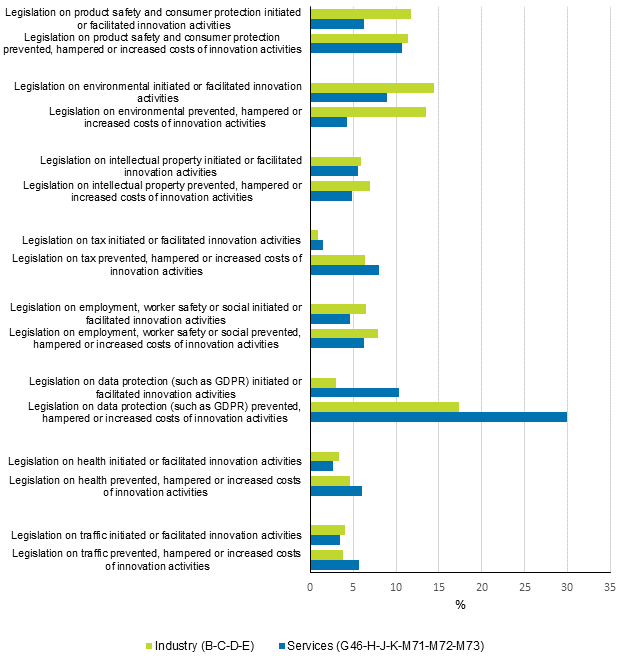10. Legislation has features both advancing and hampering innovation activity – data protection legislation influences enterprises’ possibilities to innovate
Of all enterprises in the survey, 16 per cent and almost every fourth of those with innovation activity assessed that some sub-area of legislation mentioned in the inquiry had initiated or facilitated innovation activity in 2016 to 2018. The sub-areas of legislation inquired were product safety and consumer protection legislation, environmental legislation, intellectual property rights, tax legislation, employment, worker safety or social affairs legislation, data protection (such as GDPR), health legislation and traffic legislation. Only a few per cent of enterprises with no innovation activity assessed the importance of legislation was positive for innovation activity.
Every fourth of all enterprises felt that legislation prevented or hampered innovation activity or that legislation increased the costs of innovation activity. Roughly every third enterprises with innovation activity assessed so, as did nine per cent of enterprises with no innovation activity.
Two out of three respondents to the inquiry answered that said sub-area of regulation had no effect on innovation activity or that they were not relevant to innovation activity.
Big enterprises felt more generally than smaller ones that legislation or regulation had some effect on innovation activity.
The results show that innovation activity was most influenced by product safety and consumer protection legislation and environmental legislation, but above all by legislation related to data protection.
Product safety and consumer protection legislation appeared more positive for innovation activity in manufacturing than for service enterprises. Product safety and consumer protection legislation was seen equally generally as hampering innovation activity in enterprises with innovation activity in manufacturing and service industries. Environmental legislation has a bigger significance for manufacturing enterprises than for service industries both as advancing innovation activity but most of all as a factor hampering innovation activity. In all, environmental legislation was felt most commonly to be a factor increasing and promoting innovations than hampering them. Legislation related to intellectual property rights or health and traffic with their effects connected to innovation activity do not differ much in manufacturing and service industries.
Tax legislation was not considered to have features advancing innovation activity. In contrast, legislation related to data protection among the legislation sub-areas has most generally effects on innovation activity, most of all in service industries, such as in financing and insurance activities, information service activities, publishing activities and advertising and market research, where enterprises assessed it to have positive effects on innovation activity, but above all features preventing and hampering or increasing costs in innovation activity. In addition, in manufacturing data protection legislation was generally seen as hampering innovation activity.
Figure 14. Enterprises’ estimate of the effects of different sub-areas of legislation on innovation activity in total industry and services in 2016 to 2018, share of enterprises with innovation activity

Further information on the effects of legislation on innovation activity by industry and size category
Effect of legislation on innovation activity and factors hampering innovation activity by industry group and enterprise size categoryEffect of legislation on innovation activity and factors hampering innovation activity by industry
Source: Innovation 2018, Statistics Finland
Inquiries: Mervi Niemi 029 551 3263, Heidi Pirkola 029 551 3246, tiede.teknologia@stat.fi
Director in charge: Mari Yl�-Jarkko
Updated 23.4.2020
Official Statistics of Finland (OSF):
Innovation [e-publication].
ISSN=1797-4399. 2018,
10. Legislation has features both advancing and hampering innovation activity – data protection legislation influences enterprises’ possibilities to innovate
. Helsinki: Statistics Finland [referred: 10.3.2025].
Access method: http://stat.fi/til/inn/2018/inn_2018_2020-04-23_kat_012_en.html

